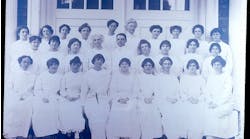A personal struggle for access to care
Dear RDH:
With amazement, I read the comments by Dianne Glasscoe, RDH, BS, regarding "Fighting Supervision Restrictions" in the August 2004 issue. Her comments parallel my own struggle for less restrictive supervision in Georgia.
As a dental hygienist - but most importantly, as a mother of a severely retarded adult daughter who has been denied dental care at Georgia Regional Hospital in Savannah - this has become my "personal" battle.
My daughter, along with hundreds, perhaps thousands of developmentally disabled adults in Georgia, are being denied dental care due to budget cuts in our state hospitals. Along with the federally mandated Olmstead Act (transferring developmentally disabled adults confined in institutions into community group homes), this crisis will only continue to escalate. The only option available for our developmentally disabled adults living in their own homes and in community group homes in rural southeast Georgia is a six-hour round trip to a state hospital in Augusta. However, this is not an option for my mentally and medically fragile daughter and many of our other disabled adults.
As dental professionals, we are aware that an individual's oral health is detrimental to their overall health, especially for those who are as medically fragile as the disabled and the elderly population.
Also, Dianne's assessment of membership in the ADHA as well as in state-sponsored associations most definitely reflects what exists in Georgia.
I want to personally challenge the states that have not passed some form of dental care access to these most vulnerable of our population to unite together in an effort to address this crisis. Perhaps, through collaboration with states that have been successful, we may be able to find a solution.
As a parent, I will continue to advocate for my daughter and thousands across Georgia like her, who are unable to speak for themselves. I sincerely hope that someday in the very near future, access to dental care will become a "right" for every citizen across the United States.
Beth Roach, RDH
Jesup, Georgia
Editor's Note: Naturally, we prefer to "print" correspondence between letter writers. So we do not print contact information in the Readers' Forum. However, given the nature of Ms. Roach's letter, we provide her email address: [email protected]. But keep us in mind if you would like to comment "publicly" on her letter.
Florida Probe vs. voice activation
Dear RDH,
I am writing in response to the letter from Beth Kageyama, RDH, that was published in the August issue's Reader's Forum. In it, she expressed her frustration with the voice-activated periodontal charting software that she had tried.
I have been a clinical hygienist for 21 years now. Like many of us, I have seen tremendous changes within our profession during that time. For me, by far the most challenging, yet exciting changes have been in the arena of periodontal screening and treatment options for our patients. It was hard to say goodbye to the comfortable paradigm of "gross scale," "fine scale" that we depended on. But I can honestly say that I love my profession now more than ever, and I especially like to treat periodontal disease.
We are surrounded by mounting evidence supporting the negative impact that chronic inflammation has on total body health. Those of us who went into the field to "clean teeth" have had to fire the cleaning lady and step into the role of "primary disease intervention specialists." After all, aren't we the ones responsible for informing our patients as to where they stand as part of this silent disease epidemic? We would like to think so. Patients trust us. They assume that if they are following their half of the equation by visiting their dentist regularly, that surely they would be informed if they had any sort of periodontal problem.
I recently had the pleasure of hearing Roger Levin of Levin Management Group speak while he was in town. For those of you not familiar with Dr. Levin, he heads the largest dental practice management firm in the United States. He is a highly respected educator and author in the field of dentistry.
During Dr. Levin's lecture, he threw out this startling fact: According to recent office surveys conducted by his firm, over 70 percent of dental offices still are not probing their patients regularly! Offices that have been regularly screening their patients' periodontal condition find this hard to believe, but I don't. I have worked many temporary assignments with practices over the last five years. I have been in too many offices to count. But what did stand out in my mind was how rarely I found a practice where there was a full fledged screening process in place. I gradually became too discouraged by the number of offices where patients with bleeding gingiva and 5-6 mm pockets were routinely seen every six months for their "prophy" with no mention in the chart notes of their periodontal disease, much less any probing depths recorded, to continue down that path.
What I took away from that experience was a strong conviction that something had to change. Patients have the right to be informed when they have a disease! They should be screened regularly, and always know when they leave the dental chair what their pocket depths are and what that means to their overall health.
As a result, my career changed paths, and I have been fortunate to steer myself in the direction of providing consulting services. I have been able to help some local practices implement organized screening and treatment protocols in their hygiene departments in an effort to make sure that patients with periodontal disease don't "slip through the ..." I have also done some continuing education speaking in this arena.
All of this leads me to my point about voice-activated technology. Through my encounters with offices, I have witnessed two things. First, I meet doctors who sincerely want change, and are frustrated because their hygienists haven't revamped the department. On the flip side, I see hygienists who sincerely want to do their job to the best of their ability, but can't because of physical limitations. By that I mean, they are still sitting down to 40-minute patient appointment times with no assistance with periodontal charting.
Is it any wonder that we start cutting corners, telling ourselves that "we'll do a charting next time," while the intraoral camera sits in the corner of the operatories collecting dust? We all know too well the pressures of trying to stay on schedule, when one variable in your day can throw the whole schedule off.
To do this job in an exceptional manner, you have to have the time to educate, and the tools to collect the needed data. That's where I believe we are stuck. At some point, hygienists and doctors need to sit down together and find a solution that will work for everyone. If we can overcome these hurdles, it benefits everyone. Hygienists would no longer experience burnout seeing 10 to 12 "prophys" a day; doctors would have the joy of seeing their hygiene department's profitability increase; and, most importantly, all patients would be receiving the diagnosis that they deserve
I too, have not had good luck with voice-activated periodontal charting systems. They do work for many offices, but for just as many, they can be unreliable and frustrating. We need something that we can consistently count on for accuracy. After the initial learning curve that we experience with all new technology, the objective of having these devices is that it should make our job easier, and provide patients with the true benefits of visiting a high-tech practice.
I'd like to invite readers to investigate the Florida Probe System. I have recently been trained on this technology, and I'm very excited about this new tool. It is a non-voice activated system that allows a hygienist to perform a periodontal charting and diagnosis without needing an assistant to record.
A pressure regulated probe is walked along the sulcus, and by tapping a foot pedal the pocket depths are recorded. Best of all, the patient gets the benefit of hearing a "voice" calling out the numbers. It can record bleeding, furcation, mobility, recession, and plaque, all with the touch of a foot pedal.
Short patient education videos can be shown to patients as the hygienist is developing their X-rays, so by the time they re-enter the room, the patients understand what a periodontal probing is, and what the pocket depth numbers indicate. It also provides printed patient diagnosis sheets and patient education material when the screening is complete. And for offices treating ethnic patients, it can even "translate" into foreign languages!
I am excited by the push that dental product manufacturers are making to address a problem that has been swept under the rug for too long. I'm also excited about the possibilities for our future as dental hygienists. It's what will surely keep me around for the next 21 years!
Diane Sharp, RDH
Indianapolis, Indiana





